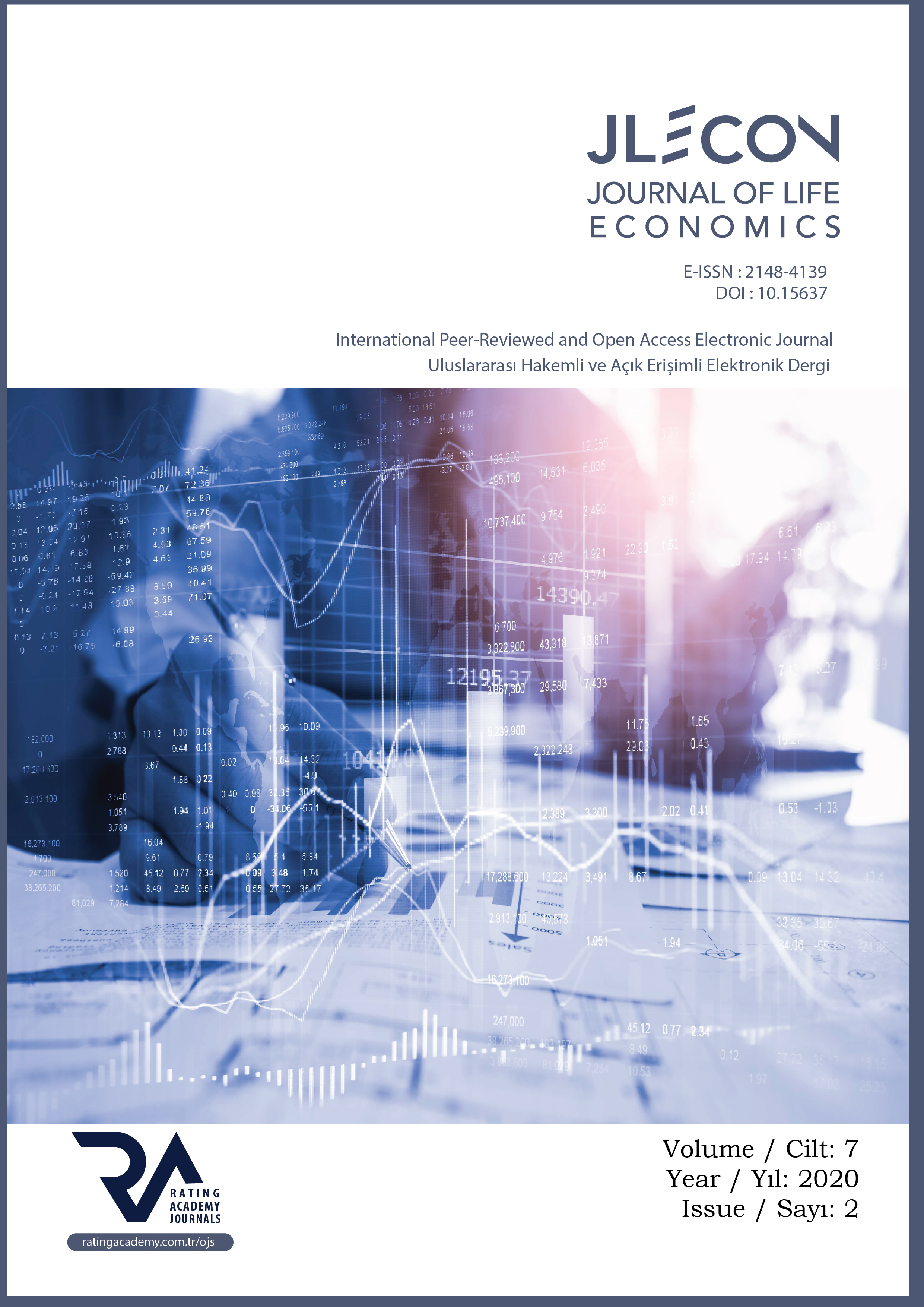A COMPARISON OF LOGISTIC REGRESSION, ARTIFICIAL NEURAL NETWORKS AND MOORA METHODS IN ESTIMATION OF THE SAFETY OF COUNTRIES
DOI:
https://doi.org/10.15637/jlecon.7.008%20Keywords:
Artificial Neural Network, Logistic Regression Analysis, MOORA, Safety, ClassificationAbstract
In recent years, because of the developments in software and hardware technology, the datasets used in research have expanded, and with the effects of artificial intelligence technologies, the models used in forecasts have enabled to obtain results with broader meanings. In this study, using the crime index calculated to reveal the crime rates in the countries every year, the safety positions of the 106 countries was estimated. For this purpose, logistic regression analysis, artificial neural networks and MOORA method, which is one of the multi-criteria decision making methods and also not a classification method, has been used to provide a different point of view. As a result of the study, it is determined that the correct classification rate of estimations made according to the safety of countries with artificial neural networks method is higher than other methods.
Downloads
References
ALTAŞ, D. & GÜLPINAR, V., (2012). Karar Ağaçları ve Yapay Sinir Ağlarının Sınıflandırma Performanslarının Karşılaştırılması: Avrupa Birliği Örneği. Trakya Üniversitesi Sosyal Bilimler Dergisi, 14(1), 1-22.
ARIKAN KARGI, V. S., (2015). Yapay Sinir Ağ Modelleri ve Bir Tekstil Firmasında Uygulama. Bursa: Ekin Basın Yayın Dağıtım. ISBN: 9786055187620
AYYILDIZ, E., (2018). Amerika Basketbol Ligi (NBA) Maç Sonuçlarının Yapay Sinir Ağları ile Tahmini. Gaziantep Üniversitesi Spor Bilimleri Dergisi, 3(1), 40-53.
BADDELEY, M. & Barrowclough, D., (2009). Running Regssions A Practical Guide to Quantitative Research in Economics, Finance and Development Studies. Edinburg, UK: Cambridge University Press. ISBN: 978-0521603089
BİLGİN, M. & YILMAZ, A., (2018). Makine Öğrenmesi: Makine Öğrenmesi Teorisi ve Algoritmaları. 2. dü. İstanbul: Papatya Bilim. ISBN: 978-605-9594-25-7
BRAUERS, W. K. M., (2018). Location Theory and Multi-Criteria Decision Making: An Application of the MOORA Method.. Contemporary Economics, 12(3), 241-252.
BRAUERS, W. & ZAVADSKAS, E., (2006). The MOORA Method and Its Application Privatization in a Transition Economy. Control and Cybernetics, 35(2), 445-469.
BUDAK, H. & ERPOLAT, S., (2012). Kredi Riski Tahmininde Yapay Sinir Ağları ve Lojistik Regresyon Analizi Karşılaştırması. Online Academic Journal of Information Technology, 3(9), 23-30.
CHEN, C. L., HSIN, H. C., CHEN, Y. H. & NANG, S. Y., (2014). Predictive Models for Pre-operative Diagnosis of Rotator Cuff Tear: A Comparison Study of Two Methods between Logistic Regression and Artificial Neural Network. Applied Mechanics and Materials, Cilt 595, 263-268.
CIABURRO, G. & VENKATESWARAN, B., (2017). Neural Networks with R: Smart models Using CNN, RNN, Deep Learning, and Artificial Intelligence Principles. Birmingham: Packt Publishing. ISBN: 978-1-78839-787-2
ÇAKIN, E. & ÖZDEMİR, A., (2019). Veri Zarflama Analizi Temelli Yapay Sinir Ağları ve Lojistik Regresyon Analizi ile Teknoloji Geliştirme Bölgelerinin Etkinliklerinin Tahminlenmesi. Hacettepe Üniversitesi İktisadi ve İdari Bilimler Dergisi, 37(2), 271-293.
FİLİZ, E., KARABOĞA, H. A. & AKOGUL, S., (2017). BIST-50 Endeksi Değişim Değerlerinin Sınıflandırılmasında Makine Öğrenmesi Yöntemleri ve Yapay Sinir Ağları Kullanımı. Ç.Ü. Sosyal Bilimler Enstitüsü Dergisi, 26(1), 231-241.
GADAKH, V., SHINDE, V. & KHEMNAR, N., (2013). Optimization of Welding Process Parameters Using MOORA Method. International Journal of Advanced Manufacturing Technology, 69(9-12), 2031-2039.
GAMACHE, K., GIARDINO, J. R., ZHAO, P. & OWENS, R. H., (2018). Bivouacs of the Anthropocene: Urbanization, Landforms, and Hazards in Mountainous Regions. %1 içindeUrban Geomorphology: Landforms and Processes in Cities. London: Elsevier, 205-230.
GREENE, W. H., (2012). Econometric Analysis. USA: Pearson Education Inc. ISBN: 0-13-066189-9
GÜRİŞ, S. & ÇAĞLAYAN, E., (2005). Ekonometri Temel Kavramlar. İstanbul: Der Yayınları. ISBN: 9789753535298
HILL, R. C., GRIFFITHS, W. E. & LIM, G. C., (2011). Principles of Econometrics. USA: Wiley. ISBN: 978-0-470-62673-3
Kennedy, P., 2008. A Guide to Econometrics. (2008): Blackwell Publishing. ISBN: 978-1405182577
KUMAR, H. & GIRI, S., (2019). A Flow Shop Scheduling Algorithm Based On Artificial Neural Network. Bulletin of Pure and Applied Sciences, 38(E)(1), 62-71.
MCCULLOCH, W. S. & PITTS, W., (1943). A logical calculus of the ideas immanent in nervous activity. Bulletin of Mathematical Biophysics, Cilt 5, 115-133.
MOHAMED, A. E., (2017). Comparative Study of Four Supervised Machine Learning Techniques for Classification. International Journal of Applied Science and Technology , 7(2), 5-18.
NUMBEO, (2019). Numbeo Crime Index by Country 2019. [Çevrimiçi] : Crime Index by Country 2019, https://www.numbeo.com/crime/rankings_by_country.jsp?title=2019 [Erişildi: 21.9.2019].
YAKUBU, A., DAHLOUM, L., SHOYOMB, A. & YAHAYA, U., (2019). Modelling hatchability and mortality in muscovy ducks using automatic linear modelling and artificial neural network. Journal of the Indonesian Tropical Animal Agriculture, 44(1), 65-76.
Downloads
Published
How to Cite
Issue
Section
License
Copyright (c) 2020 Jolistence Publications

This work is licensed under a Creative Commons Attribution 4.0 International License.
When the article is accepted for publication in the Journal of Life Economics, authors transfer all copyright in the article to the Holistence Publications.The authors reserve all proprietary right other than copyright, such as patent rights.
Everyone who is listed as an author in this article should have made a substantial, direct, intellectual contribution to the work and should take public responsibility for it.
This paper contains works that have not previously published or not under consideration for publication in other journals.













